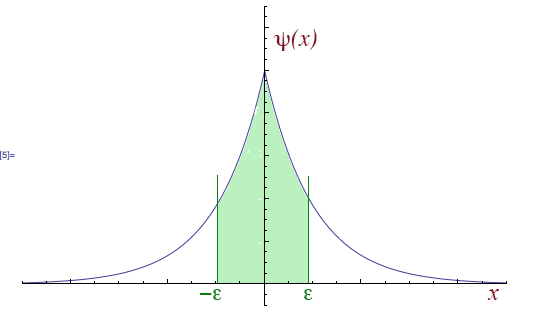
Delta function potential
Consider the delta function potential potential $$V(x)=-\alpha\delta(x).$$
The time-independent Schrödinger equation: $$-\frac{\hbar^2}{2m}\frac{d^2\psi}{dx^2}-\alpha\delta(x)\psi=E\psi.$$
Bound states: $E\lt 0$
$$-\frac{\hbar^2}{2m}\frac{d^2\psi}{dx^2}-\alpha\delta(x)\psi=E\psi.$$
Everywhere except at the origin $V(x)=0$, so a bound state would have an energy $E<0$:
$$\frac{d^2\psi}{dx^2}=-\frac{2mE}{\hbar^2}\psi=\kappa^2 \psi,\label{diffeq}$$
where $\kappa$ is real and positive.
Solutions??
Short excursion on solving differential equations:
All of these are linearly independent solutions to eq (\ref{diffeq}): $e^{\kappa x}$, $e^{-\kappa x}$, $\sin(i\kappa x)$, and $\cos(i\kappa x)$. How do I know there aren't more? What's the most general solution to our 2nd order diff. eq. (\ref{diffeq})?
- The Schrödinger equation is a 2nd order diff. eq. because the highest order derivative is a second derivative.
- The general solution for a 2nd order differential equation is a linear combination (superposition) of 2 linearly independent solution.
- Two vectors $\myv a$ and $\myv b$ are linearly dependent if a scalar number $c$ exists such that: $$\myv a = c\myv b.$$
- You may choose any 2 linearly independent solutions as the "basis" for your general solution.
Since $e^{i\theta}=\cos\theta + i\sin\theta$, $$\sin\theta=\frac{e^{i\theta}-e^{-i\theta}}{2i}.$$ So, $$\begineq \sin(i\kappa x)&=\frac{e^{i^2\kappa x}-e^{-i^2\kappa x}}{2i}\\ &=\frac{e^{-\kappa x}-e^{+\kappa x}}{2i}\\ \endeq$$
You can mix 'n match any two of all possible linearly independent solution to make all possible solutions. It is a purely aesthetic choice which two you choose.
Back to our regularly scheduled program...
So the most general solution could be written ($A$ and $B$ are constants): $$\psi(x) = Ae^{-\kappa x}+Be^{+\kappa x}$$
The region $x\lt 0$
Problem: Do you see any problems with the general solution above in the region $x\lt 0$ if we eventually want to normalize $\Psi(x,0)$? What restrictions does this place on $A$ and/or $B$?
[After thinking along the same lines for the the region $x>0$...] If we assume that $\Psi(x,0)$ should be continuous, even at $x=0$, it looks like the solution everywhere could be written:
$$\psi(x)=\left\{\begin{array}{ll}
Be^{\kappa x} & \ \ \text{for }x\lt 0\\
Be^{-\kappa x} & \ \ \text{for }0\lt x\\
\end{array}\right.
$$

Problem: Do we have enough information to normalize this function?
The normalization integral is $$\begineq 1&=\int_{-\infty}^{+\infty}\psi^*\psi\,dx\\ &=\int_{-\infty}^0 B^2e^{+2\kappa x}\,dx + \int^{+\infty}_0 B^2e^{-2\kappa x}\,dx\\ &=2B^2\int^{+\infty}_0 e^{-2\kappa x}\,dx\\ &=2B^2\frac 1{2\kappa}=\frac{B^2}\kappa\\ \endeq $$ So, $B=\sqrt{\kappa}$.
What $\kappa$ should we use?
- Any old $\kappa$ can satisfy the boundary condition of continuity of $\psi(x=0)$.
- The slope $\psi'(x)$ certainly changes discontinuously at $x=0$, but is any old change of slope allowed? Or is *that* restricted?
Dynamic plot of $\psi(x)=\sqrt{\kappa}e^{-i|\kappa|x}$ along with tangent lines at $x=0$.
It turns out that we can find the exact discontinuity in the slope if we...
Integrate the Schrödinger equation
Re-arrange the time-independent Sch equation to read: $$E\psi(x)+\frac{\hbar^2}{2m}\frac{d^2\psi(x)}{dx} = V(x)\psi(x). $$

Integrating both sides of this equation over the region shown above:
$$\int_{-\epsilon}^{+\epsilon}E\psi\,dx+
\int_{-\epsilon}^{+\epsilon}
\frac{\hbar^2}{2m}\frac{d^2\psi}{dx^2}\,dx=
\int_{-\epsilon}^{+\epsilon} V\psi\,dx.$$
We're going to take the limit, as $\epsilon\to 0$ of this. Consider the terms one by one:
- For small $\epsilon$, $$\begineq\int_{-\epsilon}^{+\epsilon} E\psi(x)\,dx&\approx E\psi(0)[\epsilon-(-\epsilon)]\\ &=E\psi(0)2\epsilon\\ &\stackrel{\epsilon\to 0}{\rightarrow} 0.\endeq$$
- The second term: $$\begineq\int_{-\epsilon}^{+\epsilon}\frac{\hbar^2}{2m}\frac{d}{dx}\frac{d\psi}{dx}&=\frac{\hbar^2}{2m}\left[\frac{d\psi}{dx}\right]_{-\epsilon}^{+\epsilon}\\ &=\frac{\hbar^2}{2m} \left(\left.\frac{d\psi}{dx}\right|^{+\epsilon}- \left.\frac{d\psi}{dx}\right|^{-\epsilon}\right)\\ &\stackrel{\epsilon\to 0}{\rightarrow} \frac{\hbar^2}{2m} \left(\left.\frac{d\psi}{dx}\right|^{x=0^+}- \left.\frac{d\psi}{dx}\right|^{x=0^-}\right)\\ &\equiv \frac{\hbar^2}{2m}\Delta\\ \endeq $$
- For the last term, if $V(x)$ is a delta function potential:
$$\begineq
\int_{-\epsilon}^{+\epsilon}V\psi\,dx&=-\alpha
\int_{-\epsilon}^{+\epsilon}
\delta(x)\psi(x)\,dx\\
&=-\alpha\psi(0)\int_{-\epsilon}^{+\epsilon}\delta(x)\,dx\\
&=-\alpha\sqrt\kappa
\endeq$$
Using the properties of delta functions $$?= -\alpha\psi(0)\int \delta(x)\,dx= -\alpha B.$$
Notice that, if $V(x)$ had been finite the 2nd term would also vanish and we would have had: $$0=\Delta =\left.\frac{d\psi}{dx}\right|^{+\epsilon}- \left.\frac{d\psi}{dx}\right|^{-\epsilon},$$ and in the limit of $\epsilon\to 0$ this implies that $\psi'(x)$ is continuous.
But for this bound state of the dirac delta function, we get instead: $$\begineq \frac{\hbar^2}{2m} \left(\left.\frac{d\psi}{dx}\right|^{+\epsilon}- \left.\frac{d\psi}{dx}\right|^{-\epsilon}\right)&=-\alpha B\\ \frac{\hbar^2}{2m} \left(\left.-\kappa Be^{-\kappa x}\right|^{+\epsilon}- \left.\kappa Be^{\kappa x}\right|^{-\epsilon}\right)&=-\alpha B\\ \frac{\hbar^2}{2m}(-2\kappa B)&=-\alpha B.\endeq$$ Re-arranging: $$\kappa = \frac{m\alpha}{\hbar^2}.$$
The energy is $$E=-\frac{\hbar^2\kappa^2}{2m}=-\frac{m\alpha^2}{2\hbar^2}.$$
Now at last we are in a position to normalize the function, and eventually we find
$$\psi(x)=\frac{\sqrt{m\alpha}}{\hbar}e^{-m\alpha|x|/\hbar^2}.$$
Can you make an argument for why there should (or should not) be more than one bound state?
Try solutions with the same discontinuity in the derivative...wouldn't other ones be possible?
But then, try to construct ones that are also continuous. Not possible.
Why?? what's the justification for $\psi(x)$ being continuous.
Scattering states: $E\gt 0$
$$-\frac{\hbar^2}{2m}\frac{d^2\psi}{dx^2}-\alpha\delta(x)=E\psi.$$
Everywhere except at the origin $V(x)=0$, so $$\begineq\frac{d^2\psi}{dx^2}&=-\frac{2mE}{\hbar^2}\psi\\ &\equiv&-k^2 \psi,\label{diffeq2}$$ where $k= \frac{\sqrt{2mE}}{\hbar}$ is real and positive.
Solutions??
$e^{ikx}, e^{-ikx}, \sin(kx), \cos(kx), \sin(kx+C), ...$
Following our prescription for a 2nd order differential equation...

Solution for $x \lt 0$: $\psi^-(x)=Ae^{ikx}+Be^{-ikx}$
Solution for $ 0\lt x$: $\psi^+(x)=Fe^{ikx}+Ge^{-ikx}$
4 Unknowns, $A,B,F,G$. What equations can we come up with to constrain these constants?
Your turn now...- General restrictions on $A$, $B$, $F$, $G$ in order for solutions to be normalizable?
Erm, not normalizable so NONE :-<
- Apply continuity of $\psi(x)$ at $x=0$.
$$ \begineq \psi^-(0)&=\psi^+(0)\\ Ae^{ik0}+Be^{-ik0}&=Fe^{ik0}+Ge^{-ik0}\\ A+B&=F+G \endeq$$
- Apply known discontinuity of $\psi'(x)$ at $x=0$:
$$\begineq\Delta &= -\frac{2m\alpha}{\hbar^2}\psi(0)\\
\left.\frac{d\psi}{dx}\right|_+^{x=0} - \left.\frac{d\psi}{dx}\right|_-^{x=0}
&= -\frac{2m\alpha}{\hbar^2}(A+B)\\
\endeq$$
$$\begineq ik(F-G-A+B)=-\frac{2m\alpha}{\hbar^2}(A+B) \endeq $$Write this condition in terms of $\beta\equiv\frac{m\alpha}{\hbar^2 k}$.$$F-G=A(1+2i\beta)-B(1-2i\beta)$$
- When we tack on the time dependence *all* of these terms get the same time dependence $\phi(t)=e^{-iEt/\hbar}=e^{-i\hbar k^2t/2m}$. So, for example, $Ae^{ikx}e^{-ik^2/2m}=Ae^{ik(x-(\hbar k/2m)t)}$ is a function $f(x-vt)$ ($v\equiv\hbar k/(2m)$ which is traveling to the right. We see that the function whose amplitude is $B$ is a function $f(x+vt)$: a left-travelling function.
Let's say that there is a source of particles to the left of the delta-function well. This would be associate with the $Ae^{ikx}$ part of the solution, which is travelling rightwards in the left half of the diagram.
Use this diagram to argue about which one of $A$, $B$, $F$, $G$ is zero if particles are coming towards the well from the left:

There will be particles on the left, travelling to the right (so $A\neq 0$). Some may be reflected at the delta function back towards the left (if so, then $B\neq 0$). Some of the particles coming from the left may make it past the delta function, and will continue travelling to the right (these are the $F\neq 0$ solutions). So, if there is no source of particle on the right, then $G=0$: no particles on the right hand side which are travelling left.
- Find the ratios of the other coefficients to $A$.
- Find the "reflection coefficient" $R$: $$R\equiv\frac{|B|^2}{|A|^2}$$
Using our expression (\ref{diffeq2}) connecting energy and $k$: $$k=\frac{\sqrt{2mE}}{\hbar}$$ We can write the reflection and transmission coefficients as:
$$R=\frac 1{1+(2\hbar^2E/m\alpha^2)}$$ $$T=\frac{|F|^2}{|A|^2}=\frac 1{1+(m\alpha^2/2\hbar^2E)}$$
- General restrictions on $A$, $B$, $F$, $G$ in order for solutions to be normalizable?